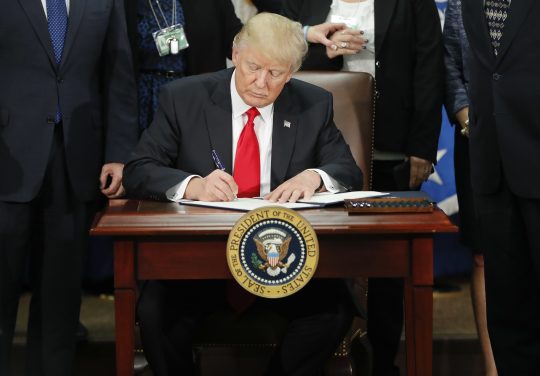President Donald Trump's executive order to eliminate two regulations for every new rule could result in zero net regulatory costs this fiscal year, a stunning shift in regulatory policy from the previous Obama administration.
The American Action Forum released a report Tuesday showing how Executive Order 13771 could significantly roll back regulatory burdens, using 2006 as a model.
The "Getting to $0" report written by Sam Batkins, director of regulatory policy at the American Action Forum, finds that through the executive orders on regulation and the Congressional Review Act, the administration could reduce net regulatory costs to zero by Oct. 1.
By contrast, the last year of the Obama presidency yielded $164 billion in costs from final regulations alone.
"With the landmark signature of Executive Order (EO) 13,771, the Trump administration has made a bold move to limit regulatory costs," Batkins writes. "But is the EO's goal of achieving $0 in regulatory costs for the remainder of the fiscal year (through October 1) possible?"
"According to American Action Forum (AAF) research, the administration need only be as restrained as the Bush Administration was in 2006 to accomplish the goal of no net costs," the report states. "With the regulatory freeze still mostly in effect, the days of $164 billion in regulatory costs could come quickly to an end."
The report notes there "have been virtually no new regulatory burdens" since the executive order was signed on Jan. 30. Trump signed another executive order on Friday that lays out how to enforce regulatory reform. The order creates a task force that will evaluate existing regulations to find ways to repeal, replace, or modify regulations that inhibit job creation, are ineffective, and impose more costs than benefits.
The report found that by returning to the average regulatory actions from just a decade ago, the executive order could reach the goal of adding no net costs.
"For example, in 2006, the Bush administration implemented 56 major regulations, imposing total costs of $14.5 billion," the report states. "This might sound like a significant sum for a conservative administration, but it is less than half the number of major rules President Obama imposed in 2016 and 8 percent of the costs."
Additionally, in 2006 the federal government reduced annual costs by $368 million.
"In other words, had EO 13,771 been applied in 2006, it would have met its goal by the end of the fiscal year," the report states.
Batkins cites some complications with attaining zero net regulatory costs. For instance, 2006 was an outlier for regulations, and at the time the Department of Homeland Security was still new and not publishing many rules, and the Consumer Financial Protection Bureau did not exist.
However, Congress can also help getting to zero net costs by using the Congressional Review Act, which allows Congress to review rules before 60 days of their effective date.
Republicans in Congress have already used the law to roll back an Obama-era rule on coal mining, and have introduced roughly 30 resolutions to repeal major Obama regulations.
"If [congressional Republicans] were to pass everything on their agenda, they could generate more than $2.4 billion in annual regulatory savings for EO 13,771, with 7.6 million fewer paperwork hours as a byproduct," Batkins writes.
"EO 13,771 has ushered in a new era for regulatory policy," the report concludes. "Now, regulators must balance the imposition of new rules against removing some of the past burden of old regulations. Regulators across the globe already engage in some form of this regulatory budgeting, but achieving $0 in net costs by October will be a challenge."
"However, a regulatory freeze, a robust retrospective effort, and a measured pace of regulation for next few months could make 'getting to $0' by the end of the fiscal year a reality," the report said.
